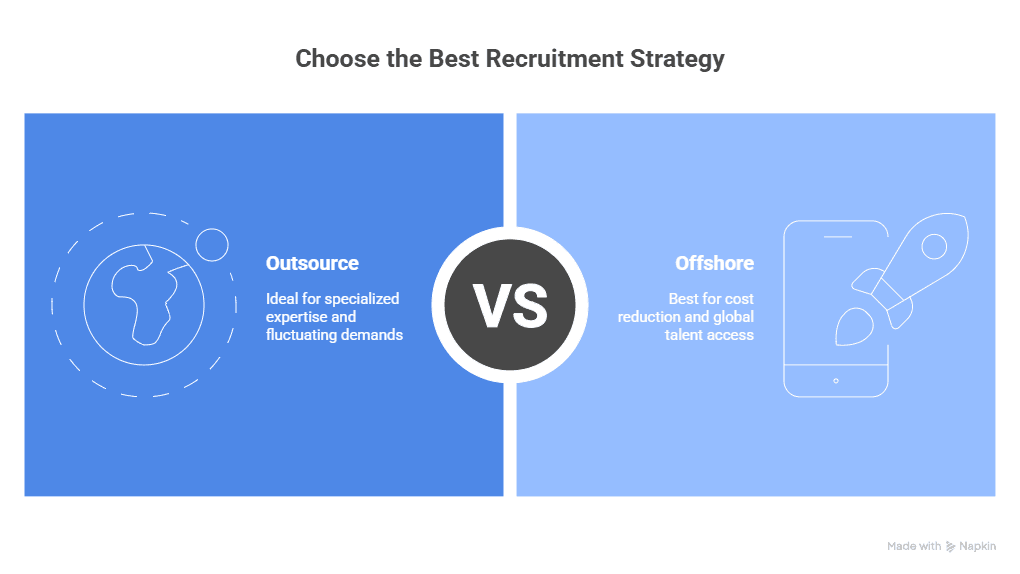What is the main difference between outsourcing and offshoring? The main difference is that outsourcing is about who does the work, while offshoring is about where the work is done. Outsourcing is delegating work to an external party, which can be local or international. Offshoring specifically means relocating operations to another country to benefit from lower costs or specialized talent.
Choosing between outsourcing and offshoring impacts how you build and manage a scalable workforce while aligning with your organization’s goals. Each approach offers unique benefits and challenges depending on factors like industry demands, budget constraints, and talent availability.
By grasping these differences, you’ll be better equipped to craft a strategy that maximizes productivity and supports sustainable growth in a competitive global market.
Comparative Table: Outsourcing vs Offshoring
This table helps recruiters, CEOs, and hiring managers compare outsourcing and offshoring options effectively when planning global recruitment strategies.
What Is Outsourcing?
Outsourcing is a business strategy that involves delegating specific business functions or tasks to external service providers. Recruiters, CEOs, and hiring managers often outsource non-core activities like payroll processing, it support, or marketing to reduce operational costs and focus on strategic goals.
You can use outsourcing in recruitment to source, screen, and onboard candidates through third-party agencies. These agencies manage processes such as job matching, candidate shortlisting, and skills assessment. For example, a company might outsource the initial screening of resumes to save time for its internal HR team.
Outsourcing offers scalability by allowing you to adjust resources based on project demands without increasing permanent headcount. This flexibility is particularly useful when filling temporary roles or handling seasonal workforce needs.
Communication flow with outsourced teams requires clear expectations and regular updates. Misaligned objectives can lead to delays or quality issues if not addressed proactively. Tracking performance metrics like time-to-fill or cost-per-hire helps optimize outcomes when working with outsourcing partners.
By leveraging outsourcing effectively, you can access specialized expertise while maintaining control over core operations.
What Is Offshoring?
Offshoring is a business strategy that involves relocating business operations, including recruitment functions, to a different country. Companies often use offshoring to reduce labor costs or access skilled talent in emerging markets. Unlike outsourcing, where third-party providers handle specific tasks, offshoring keeps operations within your organization but shifts them geographically.
Recruiters and hiring managers can leverage offshoring for sourcing, screening, and onboarding candidates in offshore locations. This approach enables you to scale recruitment efforts by tapping into larger talent pools while maintaining control over internal processes. For example, establishing an offshore team for IT or sales roles allows you to directly manage job matching and skills assessment without relying on external agencies.
Offshore staffing agencies are a huge driver for global recruitment strategies. These agencies assist with candidate shortlisting, interviewing logistics, and compliance with local employment laws. By partnering with such agencies, CEOs can optimize time-to-hire metrics while ensuring alignment with organizational goals.
Communication flow is essential when managing offshore teams. Clear instructions and regular updates help prevent delays during the recruitment funnel stages, like vetting or evaluating candidates. Using collaborative tools ensures seamless coordination between onshore decision-makers and offshore recruiters.
While cost savings drive many offshoring decisions, challenges such as cultural differences or time zone gaps may impact employee retention or engagement levels if not addressed proactively. Identifying these risks early helps refine your strategy for sustainable growth through effective global workforce management.
Outsourcing Models that Can Include Offshoring
Outsourcing models often integrate offshoring to optimize recruitment processes, reduce costs, and access global talent pools. Understanding these models helps recruiters, CEOs, and hiring managers align strategies with organizational goals.
Offshore outsourcing (external vendor + foreign country)
Offshore outsourcing involves contracting external vendors in another country to manage specific recruitment tasks. Vendors handle sourcing, screening, interviewing, and onboarding candidates while leveraging lower labor costs or specialized skills in offshore markets. For example, an IT company may outsource software developer recruitment to a staffing agency in Egypt due to its skilled tech workforce.
This model enables you to scale operations without increasing internal headcount. But, communication gaps and time zone differences can disrupt workflows if not managed effectively. Establishing clear KPIs for candidate quality and timelines ensures alignment between your team and the vendor.
Captive offshoring (internal team abroad)
Captive offshoring establishes an internal recruitment team in a foreign location under your direct control. This approach allows you to source and onboard employees through local expertise while maintaining oversight of all hiring stages. For instance, setting up a captive center in Poland provides access to European talent for sales roles.
You gain full operational control over processes like job matching and skills assessment, but must invest in infrastructure and compliance with local employment laws. To maximize efficiency, assign leadership roles within the offshore team that mirror onshore management structures.
Hybrid delivery (domestic + offshore mix)
Hybrid delivery combines domestic teams with offshore resources for flexible recruitment scaling. Domestic recruiters focus on high-level strategy or niche positions, while offshore agencies manage volume-based tasks such as initial screenings or candidate shortlisting. A hybrid model is common when expanding into new regions where cultural insights are critical.
This setup balances cost savings from offshoring with localized expertise from domestic staff. Effective collaboration tools streamline communication across locations, ensuring consistent standards during interviews or assessments regardless of geography.
Pros and Cons of Outsourcing
Outsourcing allows you to delegate specific recruitment tasks, such as sourcing or onboarding, to external providers. While it offers flexibility and cost savings, it also presents challenges that can impact your hiring strategy.
Benefits of Outsourcing
- Cost Efficiency
Outsourcing reduces operational expenses by eliminating the need for in-house resources. Third-party agencies handle processes like candidate screening and job matching at a lower cost compared to maintaining internal teams.
- Access to Expertise
External vendors specialize in recruitment functions, providing access to skilled professionals who excel in sourcing, vetting, and interviewing candidates across industries.
- Scalability
You can scale recruitment efforts quickly during peak hiring periods without increasing permanent headcount. Agencies adjust resources based on project demands.
- Faster Hiring Cycles
Outsourced teams streamline processes like skills assessment and shortlisting, reducing time-to-hire metrics critical for filling urgent roles.
- Focus on Core Operations
Delegating non-core tasks lets your internal team concentrate on strategic goals while outsourcing partners manage routine hiring activities.
Drawbacks
- Limited Control
Outsourcing shifts control over certain processes to third parties, which may lead to misaligned objectives if expectations aren’t clearly defined upfront.
- Communication Challenges
Miscommunication between recruiters and outsourced teams disrupts workflows, causing delays in candidate evaluation or onboarding phases.
- Quality Variability
The quality of hires depends heavily on the vendor’s expertise; inconsistent performance affects overall recruitment outcomes.
- Data Security Risks
Sharing sensitive employee or candidate data with external providers increases exposure to potential breaches if proper safeguards aren’t implemented.
- Cultural Misalignment
Vendors unfamiliar with your organizational culture might struggle with finding candidates who align with company values or fit long-term roles effectively.
Pros and Cons of Offshoring
Offshoring provides businesses with opportunities to reduce costs, access global talent pools, and scale operations. But it also introduces challenges that can impact recruitment efficiency and employee satisfaction.
Benefits of Offshoring
- Cost Savings
Offshoring reduces labor expenses by hiring candidates in countries with lower wage rates. This approach helps CEOs allocate budgets effectively while maintaining operational quality.
- Access to Skilled Talent
Recruiters gain access to specialized professionals in emerging markets. Offshore staffing agencies assist with sourcing, screening, and shortlisting qualified candidates for roles requiring niche expertise.
- Scalability
Offshoring enables hiring managers to scale recruitment efforts during peak periods without increasing domestic headcount. Offshore teams handle high-volume tasks like candidate vetting and onboarding efficiently.
- Wide Operating Hours Window
Time zone differences allow companies to maintain continuous workflows. Offshore recruiters manage processes such as job matching or skills assessments outside standard onshore business hours.
- Market Expansion
Establishing offshore operations supports entry into new regions by building local teams familiar with cultural nuances and compliance requirements.
Drawbacks
- Communication Barriers
Language differences or unclear instructions disrupt collaboration between onshore decision-makers and offshore recruiters. Miscommunication delays hiring timelines or impacts candidate experience.
- Cultural Differences
Variations in work culture affect alignment on performance expectations or feedback cycles, leading to potential misunderstandings during the recruitment funnel stages like interviewing or onboarding.
- Time Zone Challenges
While beneficial for 24/7 operations, time zone gaps complicate real-time coordination for urgent tasks such as last-minute interview scheduling or offer negotiations.
- Compliance Risks
Navigating foreign employment laws requires significant effort from HR teams and legal advisors when managing contracts, payrolls, or benefits for offshore employees.
- Initial Setup Costs
Building infrastructure for captive offshoring demands upfront investment in office spaces, technology systems, and local compliance measures before realizing long-term savings.
When to Outsource vs When to Offshore
Choosing between outsourcing and offshoring depends on your recruitment goals, operational needs, and resource constraints. Each approach offers distinct advantages based on specific scenarios.

Outsource if:
- You require specialized expertise for short-term projects. Contract third-party providers to handle tasks like candidate sourcing or skills assessment when internal teams lack the necessary experience or bandwidth. For example, outsource IT recruitment for niche roles requiring advanced technical skills.
- Your organization experiences fluctuating hiring demands. Delegate high-volume screening during peak periods to external agencies to scale operations without increasing permanent headcount. This ensures faster job matching while maintaining cost efficiency.
- You aim to reduce time-to-hire for critical positions. Engage outsourced recruiters who can expedite processes such as interviewing and onboarding by leveraging their established networks and tools.
- Internal resources are focused on core business functions. Assign non-core activities like resume vetting or background checks to external vendors so your team can prioritize strategic initiatives.
Offshore if:
- Cost reduction is a primary objective in long-term hiring strategies. Relocate recruitment functions like candidate shortlisting or employee onboarding to countries with lower labor costs while ensuring compliance with local employment laws.
- Accessing global talent pools is essential for scaling operations. Deploy offshore staffing agencies in emerging markets where skilled professionals are available at competitive rates, particularly for industries like tech or engineering.
- Total recruitment support enhances operational efficiency. Establish offshore teams in different time zones to manage round-the-clock sourcing, screening, and communication with candidates across regions.
- Expanding into new markets requires localized hiring expertise. Use offshore recruiters familiar with regional job markets, cultural nuances, and legal requirements to attract top talent effectively.
How Offshoring and Outsourcing Can Work Together
Combining offshoring and outsourcing optimizes recruitment processes by leveraging their distinct advantages. When integrated effectively, these strategies enhance scalability, reduce costs, and improve access to global talent pools.
Delegating Tasks Through Offshore Outsourcing
Outsourcing specific recruitment tasks to offshore vendors allows you to streamline operations while maintaining focus on core business functions.
For example, sourcing candidates or conducting initial screenings through offshore staffing agencies reduces the workload for your internal team. This approach ensures cost efficiency without compromising quality when scaling hiring efforts.
Enhancing Scalability with Hybrid Models
A hybrid model combines domestic teams with offshore resources, enabling you to balance localized expertise with cost-effective global support. Recruiters can assign high-volume tasks like candidate shortlisting or skills assessments to offshore teams, while retaining control over final interviews and onboarding locally.
This structure improves collaboration across locations and supports peak hiring periods efficiently.
Mitigating Risks Through Clear Communication
Effective communication between onshore decision-makers and outsourced offshore recruiters minimizes delays and misalignment. Establishing clear workflows for job matching, interview scheduling, and compliance tracking ensures consistency in meeting organizational goals. Using project management tools helps track progress across both outsourced and offshore teams.
Accessing Specialized Expertise Globally
Offshore outsourcing connects you with specialized talent unavailable domestically. For instance, IT-focused staffing agencies in emerging markets can vet technical candidates faster due to local expertise in niche skill sets. By contracting such services, you gain a brand positioning in filling critical roles quickly.
Streamlining Costs Without Sacrificing Quality
Integrating offshoring into your outsourcing strategy reduces operational expenses by utilizing lower-cost labor markets for repetitive or administrative recruitment tasks like resume screening or background checks. Meanwhile, higher-value activities remain under direct supervision of your internal team or trusted nearshore partners.
Aligning offshoring with outsourcing creates a flexible framework that adapts to shifting recruitment demands while maximizing resource efficiency globally.
Which Hiring Model Moves the Needle?
Outsourcing might shave dollars off your bottom line. Offshoring, done right, builds the team that gets you there faster. But here’s the hard truth: most businesses jump in without a strategy—and bleed time, money, and momentum.
The smart ones? They run the numbers, compare control versus cost, and choose the model that fuels growth.
That’s where Scale Army steps in. We’re not just another offshore staffing agency. We build high-performance remote teams for U.S. businesses that want results without bloated overhead. No hidden fees. No vague timelines. Just vetted talent and clear communication that works on your clock.
If you’re still debating models while your competitors are hiring offshore and scaling faster, you’re already behind.
Book a strategic call today. Let’s build a team that makes your hiring model irrelevant.
Frequently Asked Questions
What is the difference between outsourcing and offshoring?
Outsourcing involves delegating specific tasks or functions to third-party providers, often for cost savings or specialized expertise. Offshoring, on the other hand, refers to relocating business operations to another country to reduce labor costs or access skilled talent in emerging markets.
When should a company choose outsourcing over offshoring?
Outsourcing is ideal for short-term projects, accessing specialized skills, managing fluctuating hiring demands, or reducing time-to-hire. Offshoring is better suited for long-term cost reduction, global talent acquisition, quick support needs, and market expansion strategies.
How does outsourcing benefit recruitment processes?
Outsourcing helps streamline recruitment by delegating tasks like sourcing, screening, and onboarding candidates to external agencies. This approach enhances scalability during peak hiring periods while allowing internal teams to focus on core operations.
What are the main challenges of offshoring recruitment?
Offshoring challenges include communication barriers due to time zone differences, cultural misalignment with offshore teams, compliance risks with local laws, and initial setup costs for infrastructure and training.
Can outsourcing and offshoring be combined effectively?
Yes! Combining outsourcing with offshoring allows companies to leverage both models’ advantages—cost efficiency from offshore vendors and flexibility from outsourced services—creating a hybrid framework that adapts to shifting recruitment needs.
What are the pros of using an offshore staffing agency?
Offshore staffing agencies provide localized expertise in sourcing candidates abroad. They assist with compliance management, interviewing logistics, and scaling recruitment efforts efficiently while reducing operational costs.
How can companies address communication gaps in outsourcing or offshoring?
Clear communication channels are essential. Companies should establish regular check-ins via video calls or collaboration tools and ensure alignment through detailed project guidelines and expectations upfront.
Are there data security risks in outsourcing recruitment processes?
Yes. Sharing sensitive candidate information with third-party vendors poses potential data security risks. To mitigate this issue, companies must work with reputable providers who follow strict data protection protocols.
Is captive offshoring different from traditional offshoring?
Captive offshoring involves setting up an internal team in another country under full company control. Unlike traditional offshoring through third-party vendors, it requires more investment but offers greater operational oversight.
What industries benefit most from combining outsourcing and offshoring?
Industries like IT services, customer support, manufacturing, healthcare recruiting, and e-commerce benefit significantly as they require scalable solutions for global workforce management while maintaining cost efficiency.




